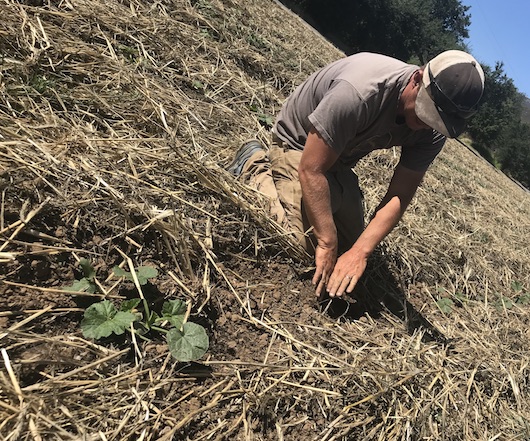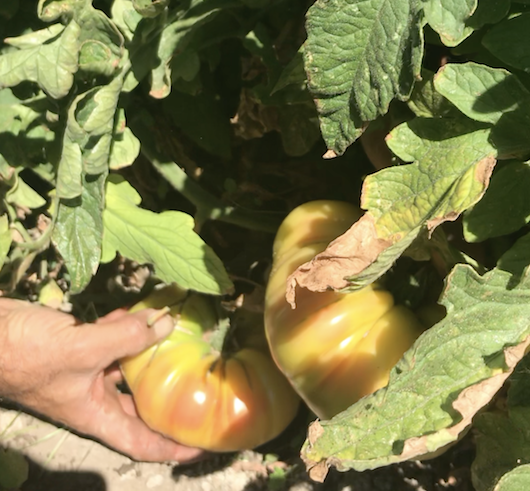
Amon looks at the soil in the no-till plot. It was irrigated several weeks ago, but is still moist despite all the heat —
We have arrived at July, a month when harvest and market are top priorities at the farm. A lot of other activities play supporting roles but the quantity and diversity of produce coming in from the fields dominate the senses and take up the bulk of our attention.
We have had a number of members express their wish that we could allow them to customize their CSA boxes in various ways, for example by choosing what produce they get. While we have developed a system for adding-on various items to the standard produce in the box, the sheer volume of activity in our packing shed and the multiple demands of the farm in general, make customization really challenging. The places that can customize produce boxes are usually one step removed from the farms that supply them; they are usually operating at a different scale of marketing than us; and they have the ability to make big investments in technology. We completely understand the interest in getting to choose what goes in the box, but our set-up is designed to keep you on your toes.
Nevertheless, we can forecast a few summer realities, one of which is that our members will be getting a regular supply of tomatoes and melons for the next few months. Andrew, who works tirelessly to make sure that the tomato fields are in good shape, reports a very good sign: There are tomatoes at all stages ripening on the plants. Some are just starting to form inside flowers, some are green and slowly ripening, while others are multiple beautiful colors and ready for market.


Opening up a flower from one of the tomato plants, Andrew demonstrates that you can see the fruit just starting to grow.
Because of the pandemic (now by far the leading cause of death globally, far ahead of other causes like influenza), Full Belly has not been allowing visitors since March. What that means is that the many tour groups that usually visit, are but a memory of times past. One way that we can share stories is through venues like this newsletter. Learning, observing and developing new practices is a continuous activity out in the Full Belly fields. In one multi-year project, Full Belly has been part of a statewide effort of several farmers trying to learn more about reducing tillage in organic vegetable production. The interest in no-till comes from the fact that these systems build healthier soil, help to store carbon and mitigate climate change.
Here, in a nutshell is the concept: Organic farmers generally grow cover crops as part of their soil building program. In no-till fields, the cover crops are killed mechanically and left on the surface of the soil. Crops are then planted into that mulch. The mulch keeps the soil cooler, helps it retain moisture, hopefully helps to reduce weeds, and provides a carbon source. Full Belly has multiple no-till fields at the moment. Each year new lessons are learned, for example about which more vigorous crops do better, the best timing and method for killing the cover crop, and how to manage the weeds.
I think it is in the DNA of Full Belly farmers, to be continuously experimenting and pushing our systems forward — so all this experimenting isn’t directly a response to the times — I think it would happen at Full Belly Farm with or without climate change. But given the times we are in, this willingness to approach farming as a new set of variables each year may be a key to adaptability. We have to develop the tools for an uncertain future, and one of those tools is adaptability itself.
—Judith Redmond

Marvel Stripes ripening near the bottom of some plants.
